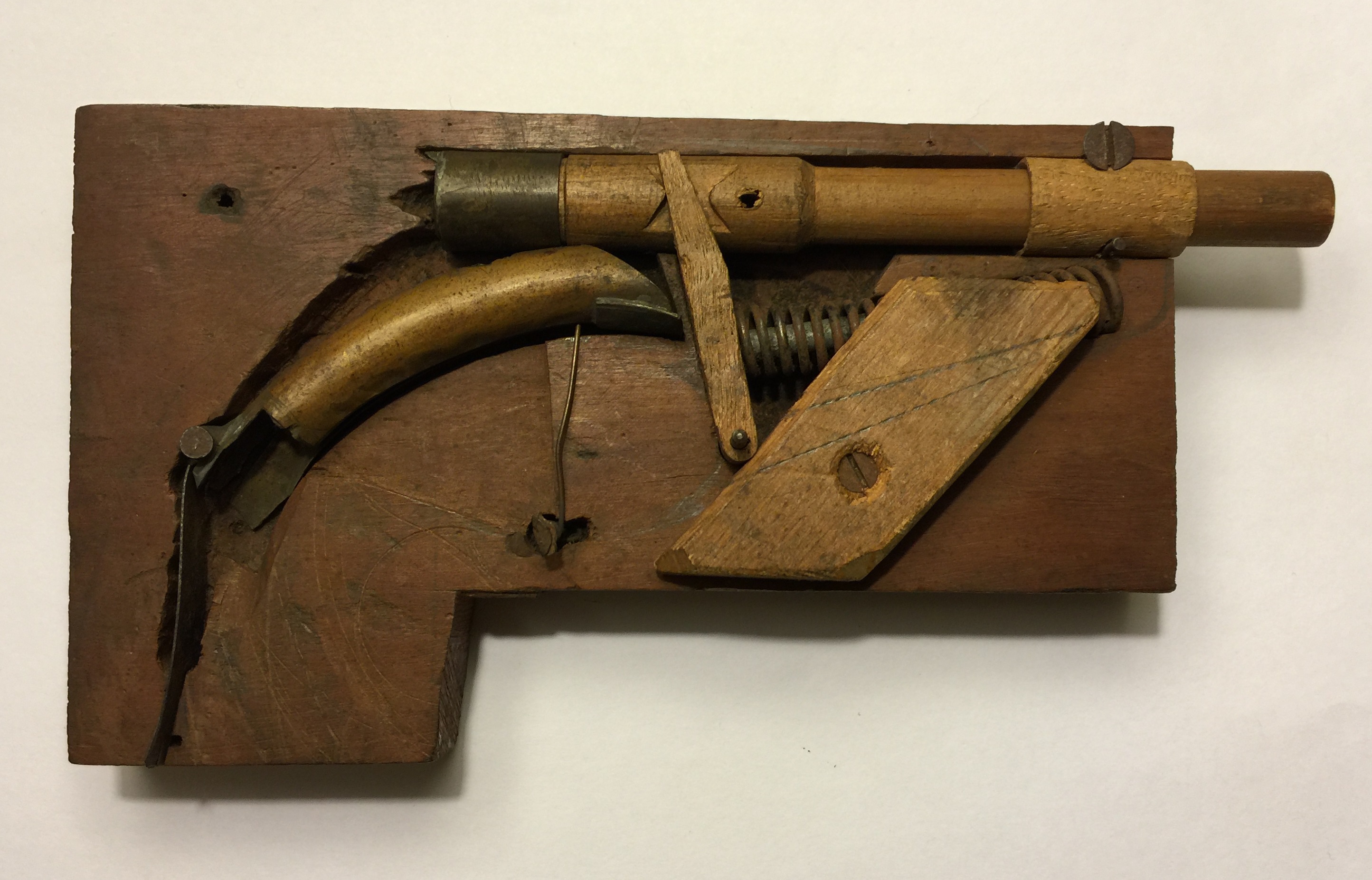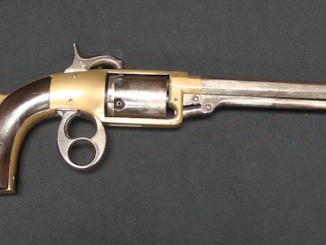The Reising was adopted by the US Marine Corps and used in campaigns through 1942 and early 1943, and it garnered a pretty poor reputation for reliability on the islands of the Pacific. However, it’s a design with a number of advantages, including light weight, good accuracy, and soft shooting. It was excellent for use outside of front-line combat.
Related Articles

Light MGs
Browning Automatic Rifle
Okay, it’s another one that’s not remotely forgotten. But we have to cover the BAR before we can effectively go into the more obscure variants of it that ARE forgotten. We’ve added a Browning Automatic […]

Semiauto pistol
Andrew Burgess’ Blow-Forward Pistols
You may recognize Andrew Burgess from guns like the Burgess folding shotgun and the 1883 Colt-Burgess lever action rifle…but you probably don’t know him for his semiauto handgun designs. Until recently, I had not even […]

Antiques
Savage & North “Figure 8” Revolver
Designed and patented in 1856 by Henry North (the grandson of company founder Simeon North), approximately 450 of these revolvers were made between 1856 and 1859. A first prototype was sent to the Washington Arsenal […]

I imagine the Reising would’ve had a very different reputation if it had gone to the air force instead of the marines, not that that was ever going to happen but still.
If the Air Force existed at the time, yes, the M50 would have been received gratefully. But the idiots in charge of the American military system in 1940 deemed air power merely as a tactical extension of the surface forces. So any base security personnel at the airfield would be forced to lug around a full-sized rifle and bayonet. “Real man’s weapons” indeed… I could be wrong.
Given the success of the American forces during the Second World War I would say your comments about the people in charge of the “military system “ are most decidedly wrong.
I said, “in 1940,” you twit. After the Pearl Harbor debacle, the US Army and the US Navy figured out that air power was a pretty good OFFENSIVE capability that could do more than mere tactical supporting strikes. The Doolittle Raid comes to mind.
Tsk tsk Cherney…
“(…)1940(…)After the Pearl Harbor debacle, the US Army and the US Navy figured out that air power was a pretty good OFFENSIVE capability that could do more than mere tactical supporting strikes.(…)”
If you claim before 1941 U.S. aviation was limiting itself to “tactical supporting strikes” how would you explain that in 1933 USAAC asked for heavy bomber with range 5000 miles maximum speed 200 mph and 2000lb internal bomb load
https://www.militaryfactory.com/aircraft/detail.php?aircraft_id=1080
?
@Daweo
Okay, smarty-pants, let me point out to you that the mission of American heavy bombers back then was NOT “fly to another country and exterminate everyone living in it.” The original stated mission of the B-17, for example, was “bomb the absolute crap out of hostile invasion fleet that is close to American shores.” You don’t launch a bomber wing from an airfield close to a beach, you do it from beyond striking distance of battleship main guns, which usually means you need a bomber’s long operating flight range just to keep the planes AND THE AIRFIELD out of battleship 16-inch gun range. And if the enemy has somehow managed to keep a beachhead, you’ve got to launch bombers from further inland unless you want to lead enemy pursuit aircraft back to your base (anyone watch the lackluster movie “Red Tails” recently? A damaged Bf-109 accidentally leads a flight of pursuing P-40’s back to its base and the P-40’s manage to destroy EVERY PARKED GERMAN AIRCRAFT AT THAT AIRBASE!!). Yes, I know that I could have messed up again.
“(…)keep the planes AND THE AIRFIELD out of battleship 16-inch gun range(…)”
Does that itself enforce range of 5000 miles?
@Cherndog
Let’s put some facts here:
The maximum range of a US 16″/50 Mark 7 gun with HC Mark 13 projectile was 41,622 yards. That was the main gun on the Iowa class battleships, which makes it the best 16″ naval gun ever in service.
In comparison, the combat range of a Do 17Z-2 medium/light bomber with a 1,000kg bomb load was 660km or 410 miles. The Do 17 was a fairly typical late 1930s twin engined bomber, albeit one with a relatively short range (which is why I chose it over American or British bombers). It is patiently obvious that one did not need a big four engined bomber for avoiding the threat of battleship guns to airfields. Any reasonably modern medium bomber would do and still you would have plenty of range left to attack the invading fleet.
There’s a nuance in American military history – the difference between what the US Congress allowed the military’s mission to be, and what the generals actually intended. Everything you’re describing is the official position. For instance, the USAAC buying B-17s to bomb menacing enemy battleships off US costs was to keep Congress happy. But a coterie of Mitchell cultists within the USAAC command was always thinking about bombing cities. Weapons were bought by Congress with an isolationist justification, and were used for something very different in overseas war.
The politicians must have been very clueless, since even the VLR (Very Long Range) bomber program, which produced the B-29 and B-32, was started already in January 1940. Here is a nice summary about program: http://www.joebaugher.com/usaf_bombers/b32.html
Most Army Air Forces base security personnel had M1 carbines The ideal weapon for someone who has to carry a weapon all day but isn’t expected to actually shoot at anyone.
In Britain there was, and is, a thing called: ‘The RAF Regiment’. It was a weak set of soldiers that the Royal Air Force decided they needed, and got, because in the 1920’s & 30’s the RAF became a spoilt child that the Daily Mail, and other newspapers, favoured. It’s combat record is a basically a big lot of sweet FA.
Unfair Brad. The RAF Regiment is a light infantry force which defends airfields, surely a useful role?
It did not come into existence until after the RAF had lost all its airfields in France in 1940 and Malaya and Burma in 1941/2, and it was realized that the army had other things to do than guard RAF bases. Nothing to do with the Daily Mail or the previous decades.
Yes, John, the Army has better things to do than guard the airfield. That’s why the RAF needs its own base security. As a general rule, airfield security should not be expected to do the job with bolt-action rifles because if hostiles have already gotten NEAR THE AIRFIELD, the best infantry weapons for getting hostiles to leave the vicinity (or surrender) will be self-loading or selectively automatic weapons.
A few years ago, I was at the US Air Force Museum in Dayton. A wax figure representing a “technician” of the US Army Air Corps on security patrol in early 1942 was carrying an M1917 Enfield bolt-action rifle with bayonet fixed. I’m pretty sure that airfields generally do not have trenches dug around them, so any riflemen guarding the base with bolt-action weapons are going to be killed off in short order if the airfield were somehow attacked by enemy infantry. I could be wrong.
@Cherndog
The exhibition at the museum was probably historically correct. The air base security forces did not get new weapons among the first, which means that they probably had to make do with bolt action rifles a little longer than US Army infantry.
The real question is whether the situation had been any better if the USAAC had become an independent Air Force earlier. In my opinion it seems unlikely, because the actual fighting forces (even the Marines) would have had a priority over the Air Force to modern weapons such as SMGs and the M1 Carbine in any case.
What would you say is the cyclic rate of this particular Reising?
Revive the Reising M60 carbine in .45 and 9×19 para and you’ll see them selling like chicken wings on football Sunday. After you’ve got your market hooked, bring out the M60ski in 7.62 Tokarev (tune it for hot military loads, natch) and laugh all the way to the bank.
Yes, yes, yes. I’d agree. The Reising M60 in .45, sans compensator or the May 1945 Smith and Wesson 9mm with M-1 carbine-style wooden stock, M-1 Garand-style safety, and took Sten magazines (unfortunately), would indeed sell well I’d think. I know I’d grab one.
I’d think that the U.S. police usage of surplus Reising SMGs, a closed-bolt .45 acp carbine capable of full-auto fire, was a prequel to the worldwide success of the HK MP5 9mm in police circles when that finally came out?
Guessing that people arent so keen on automatic weapons when they have to buy their own ammunition Dave
In the late 1980s I was on a month-long training mission to Quito with their gendarmes-like National Police. At the time, their issue weapon was the Roger Mini-14 in 5.56. They had just received a truckload of Spanish Z-83 SMG in 9mm but had not issued them; I think because the Mini-14 fit the police mission better
In their arms room they had an interesting hodgepodge of weapons, to include the Reising SMG. I snatched that guy because being the small arms guy, I wanted something interesting. So for the month-long plus training mission, I used the Reising. It was everything Dr. Ian said, and more. Interestingly, I scrounged up all the mags I could find. Most were the 12 rd type because all the 20 rd mags were taken!
As an aside, I shot it, a lot – a lot, and with new manufactured US .45 ACP ammo. And I broke TWO bolts! The chin on the bolt where the op rod impacts broke of on two bolts and I was down to the third and last bolt from the last Reising in the arms room!
But a great gun, if you’re not in the South Pacific jungle fighting the highly motivated Japanese!!
Great story Petre, thanks for posting it.